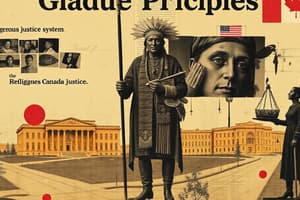Podcast
Questions and Answers
What percentage of Indigenous women accounted for female admissions to federal custody?
What percentage of Indigenous women accounted for female admissions to federal custody?
- 32%
- 33%
- 49% (correct)
- 43%
Which of the following best describes the proportion of Indigenous youth among criminalized youth?
Which of the following best describes the proportion of Indigenous youth among criminalized youth?
- 49%
- 43% (correct)
- 8.8%
- 33%
What has the Correctional Service of Canada (CSC) acknowledged regarding programming for Indigenous women?
What has the Correctional Service of Canada (CSC) acknowledged regarding programming for Indigenous women?
- It is already comprehensive.
- It needs to better address their needs. (correct)
- It focuses mainly on Indigenous men.
- It has been completely effective.
In the context of the criminal justice system, what is 'carceral redlining' primarily concerned with?
In the context of the criminal justice system, what is 'carceral redlining' primarily concerned with?
Which case is specifically mentioned in the discussion about Indigenous women and the criminal justice system?
Which case is specifically mentioned in the discussion about Indigenous women and the criminal justice system?
What action was taken by the Conservative party in response to Terri-Lynn McClintic's transfer to the Okimaw Healing Lodge?
What action was taken by the Conservative party in response to Terri-Lynn McClintic's transfer to the Okimaw Healing Lodge?
Which statement about slavery in Canada is accurate?
Which statement about slavery in Canada is accurate?
What narrative about Black women's bodies was perpetuated during slavery?
What narrative about Black women's bodies was perpetuated during slavery?
What was a significant outcome of the negative narrative around Black women's bodies?
What was a significant outcome of the negative narrative around Black women's bodies?
What issue did the application of Gladue principles in classification and reclassification face?
What issue did the application of Gladue principles in classification and reclassification face?
What is the primary characteristic of colonialism as defined in the content?
What is the primary characteristic of colonialism as defined in the content?
Which of the following is identified as a significant risk factor for Indigenous peoples' involvement in the criminal justice system?
Which of the following is identified as a significant risk factor for Indigenous peoples' involvement in the criminal justice system?
Which trend regarding incarcerated Indigenous women is highlighted from 1998 to 2008?
Which trend regarding incarcerated Indigenous women is highlighted from 1998 to 2008?
What does systemic discrimination refer to within institutions?
What does systemic discrimination refer to within institutions?
According to the content, what percentage increase was seen in incarcerated Indigenous women from 2008 to 2018?
According to the content, what percentage increase was seen in incarcerated Indigenous women from 2008 to 2018?
What age group has a higher occurrence of self-injury among criminalized Indigenous women?
What age group has a higher occurrence of self-injury among criminalized Indigenous women?
What does structural racism encompass according to the provided content?
What does structural racism encompass according to the provided content?
What specific attention does Bill C-41 urge in terms of sentencing?
What specific attention does Bill C-41 urge in terms of sentencing?
What is one of the consequences of colonialism mentioned in the content?
What is one of the consequences of colonialism mentioned in the content?
What characterizes the overrepresentation of Indigenous people in the criminal justice system?
What characterizes the overrepresentation of Indigenous people in the criminal justice system?
What was the outcome of Jamie Tanis Gladue's initial trial regarding her sentence?
What was the outcome of Jamie Tanis Gladue's initial trial regarding her sentence?
Which factors must judges consider according to the Gladue principles?
Which factors must judges consider according to the Gladue principles?
What significant ruling did the Supreme Court make in the Ipeelee case?
What significant ruling did the Supreme Court make in the Ipeelee case?
What does the term 'shadow carceral state' refer to?
What does the term 'shadow carceral state' refer to?
What percentage of the federally incarcerated population in Canada is comprised of Black prisoners?
What percentage of the federally incarcerated population in Canada is comprised of Black prisoners?
What is a major criticism regarding the application of section 718.2(e)?
What is a major criticism regarding the application of section 718.2(e)?
What is the purpose of the Okimaw Ohci Healing Lodge?
What is the purpose of the Okimaw Ohci Healing Lodge?
Which of the following is a primary focus of abolitionism?
Which of the following is a primary focus of abolitionism?
Which statement accurately reflects the incarceration rates of Black women in Canada?
Which statement accurately reflects the incarceration rates of Black women in Canada?
What is a characteristic of the Aboriginal Women Offender Correctional Program (AWOCP)?
What is a characteristic of the Aboriginal Women Offender Correctional Program (AWOCP)?
What issue has been identified regarding Indigenous programming in regional facilities?
What issue has been identified regarding Indigenous programming in regional facilities?
During the period from 2013 to 2017, what was the trend observed regarding the number of incarcerated Black women in Canada?
During the period from 2013 to 2017, what was the trend observed regarding the number of incarcerated Black women in Canada?
What was one of the findings in the Ipeelee case regarding the judges' interpretation of Gladue principles?
What was one of the findings in the Ipeelee case regarding the judges' interpretation of Gladue principles?
What issue is highlighted regarding the government's documentation of Black women in incarceration?
What issue is highlighted regarding the government's documentation of Black women in incarceration?
Which alternative is emphasized by proponents of abolitionism?
Which alternative is emphasized by proponents of abolitionism?
What was a key issue in early feminist theories regarding women's deviance?
What was a key issue in early feminist theories regarding women's deviance?
What does the cost comparison between the healing lodge and traditional prison signify?
What does the cost comparison between the healing lodge and traditional prison signify?
Which of the following statements about Prime Minister Wilfrid Laurier's policies is true?
Which of the following statements about Prime Minister Wilfrid Laurier's policies is true?
Which statement accurately describes the concept of redlining?
Which statement accurately describes the concept of redlining?
Which of the following is a misconception about the corrections system regarding Indigenous peoples?
Which of the following is a misconception about the corrections system regarding Indigenous peoples?
What term describes the systemic incarceration practices targeting marginalized communities?
What term describes the systemic incarceration practices targeting marginalized communities?
What psychological effects can result from racial profiling and over-policing?
What psychological effects can result from racial profiling and over-policing?
What was Viola Desmond’s significant act in the struggle for equal rights?
What was Viola Desmond’s significant act in the struggle for equal rights?
How did mass incarceration disproportionately affect Indigenous and Black individuals?
How did mass incarceration disproportionately affect Indigenous and Black individuals?
What practice allows police to conduct identity checks without reasonable suspicion?
What practice allows police to conduct identity checks without reasonable suspicion?
What does racialization involve?
What does racialization involve?
What was the main impact of the Fair Housing Act of 1968?
What was the main impact of the Fair Housing Act of 1968?
What is the primary reason for the increasing incarceration rates among BIPOC despite declining overall crime rates in Canada?
What is the primary reason for the increasing incarceration rates among BIPOC despite declining overall crime rates in Canada?
Flashcards
Gladue Principles
Gladue Principles
Legal principles ensuring Indigenous perspectives in justice processes.
Terri-Lynn McClintic
Terri-Lynn McClintic
Convicted child killer who sparked national outrage over prison transfer.
Transatlantic Slave Trade
Transatlantic Slave Trade
Trade where Black individuals were brought to Nova Scotia for labor.
Slavery in Canada
Slavery in Canada
Signup and view all the flashcards
Jezebel stereotypes
Jezebel stereotypes
Signup and view all the flashcards
Indigenous women in CJS
Indigenous women in CJS
Signup and view all the flashcards
R v Gladue
R v Gladue
Signup and view all the flashcards
Carceral Redlining
Carceral Redlining
Signup and view all the flashcards
Indigenous youth in CJS
Indigenous youth in CJS
Signup and view all the flashcards
Healing lodges
Healing lodges
Signup and view all the flashcards
Section 718.2(e)
Section 718.2(e)
Signup and view all the flashcards
Ipeelee Case
Ipeelee Case
Signup and view all the flashcards
Okimaw Ohci Healing Lodge
Okimaw Ohci Healing Lodge
Signup and view all the flashcards
AWOCP
AWOCP
Signup and view all the flashcards
Intergenerational Effects
Intergenerational Effects
Signup and view all the flashcards
Sentencing Alternatives
Sentencing Alternatives
Signup and view all the flashcards
Culturally Relevant Programming
Culturally Relevant Programming
Signup and view all the flashcards
Regional Discrepancy
Regional Discrepancy
Signup and view all the flashcards
Colonialism
Colonialism
Signup and view all the flashcards
Sixties Scoop
Sixties Scoop
Signup and view all the flashcards
Systemic discrimination
Systemic discrimination
Signup and view all the flashcards
Structural racism
Structural racism
Signup and view all the flashcards
Overrepresentation of Indigenous peoples
Overrepresentation of Indigenous peoples
Signup and view all the flashcards
Challenges of criminalized Indigenous Individuals
Challenges of criminalized Indigenous Individuals
Signup and view all the flashcards
Incarceration rates of Indigenous women
Incarceration rates of Indigenous women
Signup and view all the flashcards
Bill C-41
Bill C-41
Signup and view all the flashcards
Purpose of sentencing
Purpose of sentencing
Signup and view all the flashcards
Intergenerational trauma
Intergenerational trauma
Signup and view all the flashcards
Intersectionality
Intersectionality
Signup and view all the flashcards
Viola Desmond
Viola Desmond
Signup and view all the flashcards
Redlining
Redlining
Signup and view all the flashcards
Mass Incarceration
Mass Incarceration
Signup and view all the flashcards
Racial Profiling
Racial Profiling
Signup and view all the flashcards
Effects of Profiling
Effects of Profiling
Signup and view all the flashcards
Racialization
Racialization
Signup and view all the flashcards
Anti-Black Racism
Anti-Black Racism
Signup and view all the flashcards
Over-policing
Over-policing
Signup and view all the flashcards
Systemic Racism
Systemic Racism
Signup and view all the flashcards
Shadow Carceral State
Shadow Carceral State
Signup and view all the flashcards
Incarceration of BIPOC
Incarceration of BIPOC
Signup and view all the flashcards
Provincially Sentenced Women
Provincially Sentenced Women
Signup and view all the flashcards
Reformation
Reformation
Signup and view all the flashcards
Abolition
Abolition
Signup and view all the flashcards
Federal Incarceration Statistics
Federal Incarceration Statistics
Signup and view all the flashcards
Alternatives to Incarceration
Alternatives to Incarceration
Signup and view all the flashcards
Study Notes
Week 3: Black, Racialized, and Indigenous Women in the CJS
- Focuses on the experiences of Black, racialized, and Indigenous women within the Canadian Criminal Justice System (CJS).
- Includes information on historical and systemic factors contributing to the overrepresentation of these groups in the CJS.
- Addresses specific issues like colonialism, slavery, redlining, and racial profiling.
- Examines the Gladue principles and their application to sentencing.
- Discusses the Okimaw Ohci Healing Lodge and other cultural programs.
- Explores the Aboriginal Women Offender Correctional Program (AWOCP).
- Explores the impact of systemic racism.
- Highlights cases like R v. Gladue and R v. Ipeelee.
- Presents statistics on Indigenous women in the CJS, including incarceration rates and demographics.
- Investigates concerns and criticisms of current correctional approaches and programs and their effectiveness.
Announcements and Reminders
- Office hours: Wednesdays, 1-2 PM via Zoom.
- Midterm: February 11th in class.
- Case study rubric: Posted by the end of the week.
This Week's Outline
- Introduction to Indigenous women and the CJS
- R v. Gladue
- Case: Terri-Lynn McClintic
- Carceral Redlining
- Effects of slavery
- Race and Racialization
- Policing of Black women
Introduction to BIPOC and the CJS
- 2022/2023: Indigenous adults accounted for 33% of federal admissions, despite being 4% of the population.
- Indigenous women accounted for 49% of female admissions, and Indigenous men for 32% of male admissions to federal custody.
- Indigenous youth make up 43% of all criminalized youth, compared to only 8.8% of the population.
- Correctional Service of Canada (CSC) acknowledges that programming needs to better address the needs of Indigenous people.
- CSC has initiated healing lodges and cultural programming; the efficacy of this remains unclear.
Colonialism and its Effects
- Colonialism is a complex combination of territorial, cultural, linguistic, political, mental, spiritual, and economic domination.
- Colonialism is driven by exploitation and oppression.
- The intent is to eradicate the individual and cultural identity of targeted groups.
- Colonialism leads to discrimination, racism, and marginalization.
- Colonialism is the largest risk factor for Indigenous people's involvement in the Criminal Justice System.
Colonialism and its effects (continued)
- Systemic discrimination: Policies and practices of an institution create and perpetuate racial inequality.
- Structural racism: Policies and practices of systems perpetuate disadvantages for racialized groups.
Indigenous Peoples and the CJS
- Indigenous people are overrepresented in the CJS.
- Compared to non-Indigenous individuals, criminalized Indigenous individuals are, on average, younger, poorer, and more likely to be incarcerated for a violent offense.
- Indigenous individuals face higher rates of unemployment/education needs and health problems.
- They experience higher rates of substance abuse, early-age abuse, parental neglect, child welfare system involvement and intergenerational trauma.
Indigenous Women and the CJS
- Between 1998 and 2008, incarcerated Indigenous women increased by 131%.
- Between 2008 and 2018, incarceration rates for Indigenous women increased by 60%.
- Indigenous women are incarcerated at a rate 12.5 times greater than non-Indigenous women.
- The average age of a criminalized Indigenous woman is 34 years.
- Indigenous women experience self-harm at a rate 17 times higher than non-Indigenous women.
Security Classification of Criminalized Women by Race
- A chart showing the percentage of Indigenous versus other racialized women in maximum vs minimum security in prisons. Data from 2012 to 2018.
1996 Reforms: Bill C-41
- Sentencing reforms were introduced in 1996 with Bill C-41.
- The primary focus of sentencing is to protect society, contributing to lawful behavior, while also imposing just sanctions.
- Sentencing should take into account potential alternative sanctions, especially for Aboriginal offenders.
R v Gladue, 1999
- Jamie Tanis Gladue, a Cree woman, was sentenced for manslaughter.
- The Supreme Court of Canada ruled that courts must consider the unique circumstances and systemic factors of Indigenous offenders, leading to the Gladue principles.
R v Ipeelee
- This 2012 case revisited and clarified the Gladue principles.
- Courts must consider the intergenerational effects of colonialism and historical trauma.
- Sentencing must explore alternatives to prison, and assess personal and background factors for Indigenous offenders.
Application of Gladue
- Despite the introduction of Gladue, rates of incarceration for Indigenous women haven't declined significantly; they are still classified as high risk.
- Issues exist in interpretation and application of Gladue principles, leading to inconsistent sentencing.
- Lack, or inconsistent application, of training further compounds the issue.
- Regional differences/discrepancies in how Gladue principles are applied.
Okimaw Ohci Healing Lodge
- A 60-bed facility in Saskatchewan designed to house incarcerated Indigenous women.
- Aims to address underlying issues and facilitate healing.
- Supported programs like cultural sensitivity and trauma-informed care amongst others.
- Costs for offender housing at the Healing Lodge were calculated.
Cultural Needs within Corrections
- The Aboriginal Women Offender Correctional Program (AWOCP) which was introduced in 2010.
- A holistic program catering to Indigenous women.
- Incorporates culturally sensitive and trauma-informed programs, as well as elder assistance.
- The program includes various components such as engagement programs alongside moderate and high intensity components.
Criticisms of Corrections
- Corrections approaches are often culturally insensitive and inadequate to the unique needs of Indigenous people, with programs frequently designed through a pan-Indigenous lens.
- Limited use of legislated approaches to reintegration for criminalized Indigenous people.
- Existing healing lodges are often not well maintained, or easy to access.
Case: "Child Killer" Terri-Lynn McClintic
- In April 2009, Terri-Lynn McClintic was sentenced in connection to a murder case.
- Her case involved extenuating circumstances of an Indigenous woman, involving background issues.
- Sparked substantial societal discussion and controversy.
Slavery
- Slavery was prevalent in Canada until 1833.
- Black individuals were forcibly brought to Nova Scotia for labor.
- The practice violated human rights amongst others.
- Individuals across different classes, including government officials and religious figures, engaged in the owning of enslaved people.
Slavery (continued)
- Control over the bodies of Black women during slavery
- Viewed as undesirable or non-feminine
- During slavery, Black women were labeled and reduced to stereotypes like "Jezebels."
- Accusations and labels of hypersexuality and availability.
- Rape legally sanctioned.
- The trauma and experiences led to reduced rights and systemic issues.
- Narratives regarding Black women perpetuated social injustices and systemic impacts.
Omission of Black and Racialized Women from Criminology
- Early feminist theories often excluded or marginalized the experiences of Black and racialized women.
- There was a lack of inclusivity in analyzing criminalized women.
- Early feminism was predominantly a white, female-driven movement, often failing to incorporate racial or gender analysis.
- A lack of intersectionality, and critical race theory elements was also present.
Viola Desmond
- Viola Desmond challenged segregation in a Nova Scotia theatre.
- Her actions sparked discussions and had an impact on the Civil Rights movement in Canada.
Redlining
- Redlining is a practice of denying loans or resources to people of color in certain neighborhoods.
- Racist real estate practices and laws often contributed to the segregation of neighborhoods. Origins of redlining are in the 1930s.
- Used primarily in the US.
- Continued presence of redlining impacts exist across different jurisdictions.
Carceral Redlining
- Carceral redlining is a form of systemic oppression, whereby incarceration practices are deliberately used as a tool for social control by targeting racialized communities.
- Historically, residential schools serve as a form of redlining for indigenous individuals.
- The practice has resulted in further marginalization and disparities.
Carceral Redlining and Mass Incarceration
- Despite decreasing crime rates, incarceration rates for BIPOC are increasing.
- Racialized prisoners are often less likely to be approved for parole or receive benefits like temporary absences.
- Indigenous and Black people are more likely than others to be marked as "undesirable".
- Data reveals disparities in parole rates for Indigenous and Black prisoners as compared to other prisoners.
Targeting of POC
- Over-policing of Black and Indigenous communities.
- Former Toronto police chief statement highlighting policing as targeting high crime regions.
- Racial profiling practices where individuals are suspected, and deemed more likely to commit crime due to ethnicity, are a systemic issue that contributes to racial injustice.
Racial Profiling
- Racial profiling is a practice that violates the ability for Black people to move freely.
- Practices like carding, or stopping by police officers asking for personal information, often based on race.
Effects of Racial Profiling
- Significant negative psychological impacts for Black communities from over-policing.
- Over-policing leads to increased PTSD, anxiety, alienation and general fear.
Racialization and Racism
- Racialization is a process of categorizing and evaluating people along racial lines.
- Anti-black racism is a form of racism targeting Black Canadians. A variety of determinants like employment, education, health, immigration and more are impacted.
- Issues surrounding this topic include racism against Black populations remaining widely ignored and prevalent, despite evidence of widespread impacts.
- Historical context like policies enacted against Black immigration have direct systemic impacts today.
Shadow Carceral State
- The shadow carceral state is an expansive and punitive state power that uses institutions like immigration, family courts, civil detention centers, and schools to implement surveillance, detention, and removal of racialized people.
Incarceration of BIPOC
- Black prisoners disproportionately make up a higher percentage of overall federal prisoners, but a smaller percentage of the Canadian population (9.3% compared to ~2.9%).
- Over the last ten years, the numbers of incarcerated Black people has risen by ~75%.
Provincially Sentenced Women
- Limited data exists regarding the incarceration rates of Black and racialized women at the provincial level; and the government does not publicly release information which makes it harder to track statistics and find exact figures for Black women.
Federally Sentenced Women
- Lack of substantial research on the incarceration rates of black women on a federal level.
- Black women who are 15 years or older account for a significant portion of federally incarcerated women (~9.12%).
- The majority of incarcerated Black women are concentrated at a federal prison in Ontario.
Abolition or Reformation
- Reformation: reforming institutions and practices (e.g., in incarceration or psychiatric facilities).
- Abolition: dismantling all incarceration systems.
- Discussion on alternative approaches to addressing societal harm.
References
- Includes cited articles and online resources for further research.
Next Week
- Reading Assignment: Chapter 6
- Quiz #2, due Feb 4
- Midterm, Feb 11th in class
- Office hours: Wednesdays, 1-2 pm via Zoom
Studying That Suits You
Use AI to generate personalized quizzes and flashcards to suit your learning preferences.




